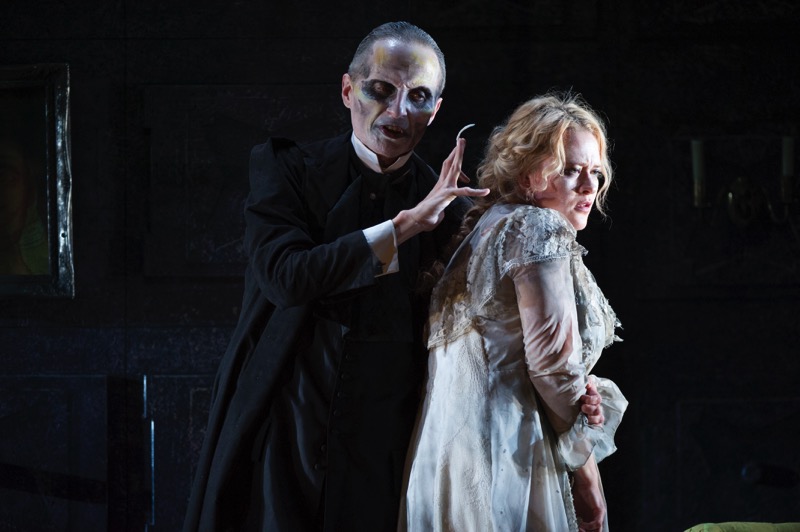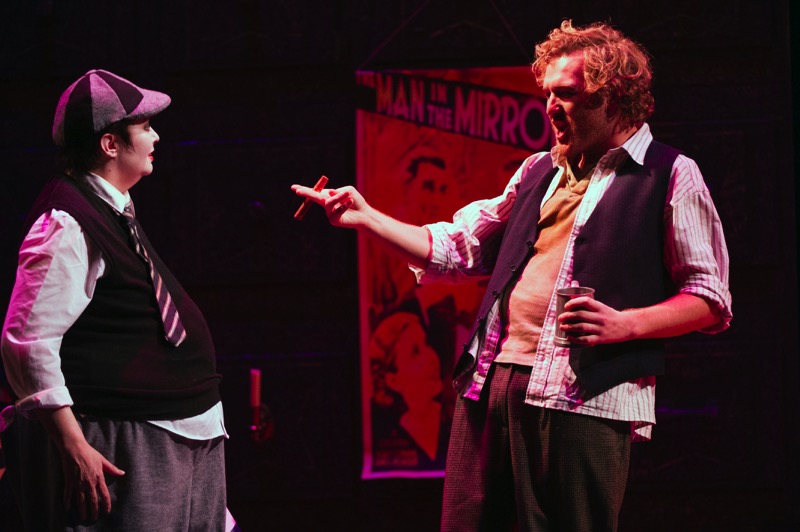The Tales of Hoffmann, English Touring Opera, ETO, Britten Theatre, RCM, October 2015
Posted on 10 October 2015Offenbach’s greatest work, which he regarded as a last chance for recognition as a composer of serious opera, remained incomplete at his death in autumn 1880. Its main character Hoffmann — jurist, composer, critic, cartoonist, and author of fantastic tales that form the basis for Nutcracker, Coppelia and Schumann’s Kreisleriana — himself became a character in a play by Jules Barbier and Michel Carré, the basis for this Offenbach opera. Its premiere four months after the composer’s death altered the original conception, but this production places the main acts, named after Hoffmann’s three previous lovers, in their correct order: Olympia, Antonia, and Giulietta.

Olympia, all images ETO/ Richard Hubert Smith
The essential story is that Hoffmann is about to lose his mistress Stella to Count Lindorf, and while in a state of inebriation with drinking friends recalls the stories of his previous lovers. Lindorf appears as the poet’s nemesis in each case: as Coppelius, co-inventor of the mechanical doll Olympia; as Dr. Miracle whose anti-Hippocratic antics will destroy Antonia; and as Dapertutto who persuades the Venetian courtesan Giulietta to steal Hoffmann’s reflection from a large mirror. In the end, after Hoffmann has killed Giulietta’s other lover Schlemil, and after his constant companion Nicklausse — doubling as his Muse — remains unharmed, Stella is lost to Lindorf and the Muse encourages him to convert his experiences into poetry.

Dr Miracle and Antonia
An extraordinary story about an extraordinary man, converted by director James Bonas into a heavily theatrical production. I particularly liked the Kleinzach interlude during the Prologue when the drinking friends create an image of the little fellow on a tabletop. Dark lighting by Mark Howland showed the dreaded Dr Miracle in silhouette before he finds his way in, and Oliver Townsend’s designs allowed different incarnations of Lindorf to emerge from a narrow cupboard — no shortage of melodrama here.

Nicklausse and Hoffmann
As Offenbach originally intended, the ETO have embodied all three lovers in the same soprano — a difficult role very ably sung by Ilona Domnich — and Lindorf’s four incarnations were sung with huge strength by Warwick Fyfe though I would prefer less volume and more depth. His hugely theatrical portrayal may work better in larger theatres but tended to overpower the relatively small orchestra, which occasionally needed more energy under the baton of Philip Sunderland. No such problem with the lyrical singing of Sam Furness, who made a beautifully convincing Hoffmann, poet and visionary rescued from his own excesses by the Nicklausse of Louise Mott, whose final soliloquy as the Muse was beautifully sung. Fine theatrical and vocal support from other members of the cast, particularly Adam Tunnicliffe and Matt Ward, in a production that should adapt well to spaces larger than the Britten Theatre at the RCM.

Stella abandons him
Performances are sold out in London, but continue on tour at: Buxton Opera House, 17th Oct; Malvern Theatres, 23rd Oct; Gala Theatre, Durham, 27th Oct; Harrogate Theatre, 31st Oct; West Road Concert Hall, Cambridge, 6th Nov; Theatre Royal Bath, 10th Nov; Snape Maltings Concert Hall, 14th Nov; Exeter Northcott Theatre, 19th Nov; Exeter Northcott Theatre, 21st Nov.


Another well constructed review, Mark — a delight to read. Thanks very much.